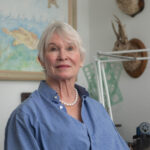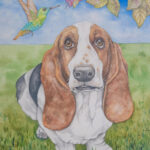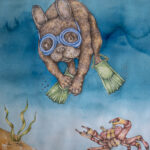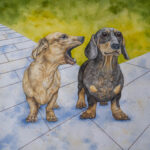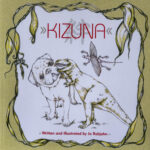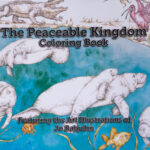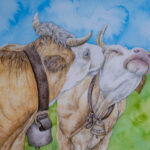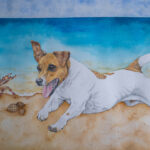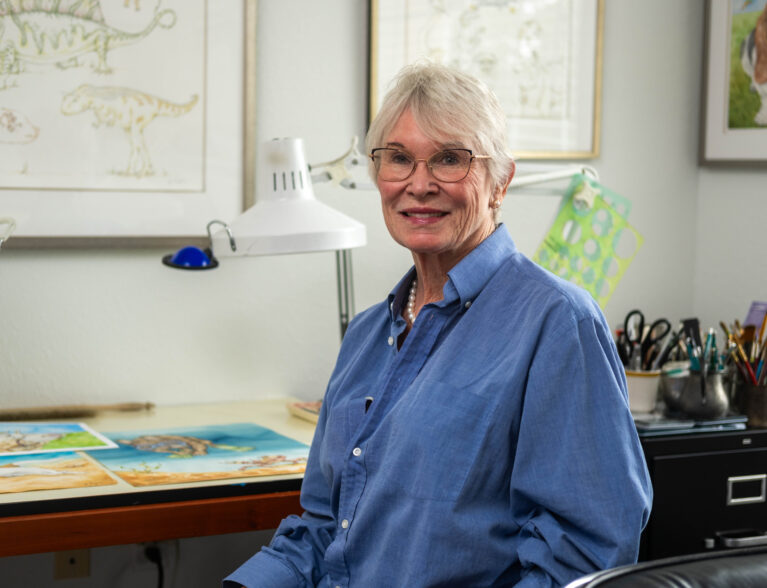
From Sun Valley California to the Florida Sunshine State and many meridians between, Jo Rabjohn has lived an enviable artist’s life. The many facets to Rabjohn’s creativity have made her a star in several artistic arenas.
The vibrant Vero resident is a best-selling architectural design author, an illustrator and author of children’s books, a former teacher at Parsons School of Design in New York City, and a creator of award-winning children’s toys.
“There was something within me which I noticed as early as first grade. I could draw. It saved me through the years. And I drew better than any of the [other] children. In fact, I thought ‘what was wrong with them’ because they couldn’t draw,” she explains with an infectious chortle.
Rabjohn says that as a child in Glendale, Calif., her strict father meted out harsh discipline.
Though a successful businessman, his temper often rose to an explosive pitch.
Through art, Rabjohn says she was able to channel her emotions without fear of reprisal, and thus, her protective shield of artistic expression emerged and flourished.
“When I was in high school, my art was selected as best in the show and then won best in the state.”
After attending Scripps College for one year, she moved to Reno to study at the University of Nevada, breezing through degrees in both sociology and fine arts. Despite her economically stable parents, Rabjohn worked to support her college days.
Just a stone’s throw from the university was the bing-bong excitement of Reno’s casinos, where she was employed as a stickman, handling the bets, calling out the rolls while other dealers handled the payouts, and managing whatever other aspects of the game were required.
“My college days were classes, do my art, my nights go to the casino to work until 3 in the morning, sleep, and the next day it would start again. I also dealt the game of 21, and sometimes was the croupier for the roulette table. You had to be quick with math, which I was, so people would keep playing,” says Rabjohn, beaming as she recalls her hectic collegiate days.
Her all-American good looks and engaging personality no doubt also served Rabjohn well.
The experience of studying gamblers’ eyes and their gamut of facial expressions eventually played out in her watercolor paintings years later. “The eyes are the window to the soul” is an adage that inescapably comes to mind when viewing Rabjohn’s art.
“My process is always to begin with the eyes. The expression in the eyes relates the feelings and character and is further reflected in their poses. The eyes help convey the story. An inner soft voice guides me.”
She believes that she inherited the “art gene” from her paternal great-grandfather, the famous artist Thomas Henry Rabjohn (1852-1943). Some of his rare landscape oil paintings are displayed in her home, others sell at auction. His Rabjohn Gallery was one of the first art galleries in San Francisco. The building withstood the 1906 fire and earthquake and today is the home of the well-known store Gump’s San Francisco.
Rabjohn, though, did not follow her great-grandfather’s signature style of rolling hills and green pastures. Rather, hers would be a complete departure that only Rabjohn could create.
The anthropomorphic animals she draws and paints with watercolor may at first glance seem wildly whimsical, while also revealing unmistakably familiar, deep human emotions. It is clear that her creatures care for one another.
There is love and tenderness and a family-like bonding among the characters on every page of her children’s books. The animals’ heartfelt expressions make it clear to the reader how alike we are to them.
Rabjohn’s toy animal inventions were the springboard to the characters she later created in her first children’s book “Kizuna.”
Her creations of soft cuddly dinosaurs made the Manhattan Toy Company and its founder, Francis Goldwyn, a success, and won the company Toy of the Year awards four consecutive years.
Those same characters eventually flowed across the pages of her books.
“I always know what animal I’m going to paint. I have an image in my mind after studying animal photographs.
“I draw and paint freehand, but accuracy and detail are very important to me. I may darken or lighten backgrounds and the characters with shadows, yet always with precision,” she explains.
Her imaginative writing and paintings shine in her picture books.
Such quirky character names as Myrtle Snackle and Oki Doki combine with creative storylines to bring both laughter and wonder to “Kizuna,” a book about Japan’s earthquake and tsunami of March 11, 2011.
The book has a fantasy twist where dinosaurs emerge from ocean depths and encounter land animals, and Rabjohn’s prose and drawings tell of adventures and compassion found in times of crisis.
In 2006, Rabjohn authored “Sun Valley Architecture and Interiors,” with a foreword by Muriel Hemingway, which continues to be a best seller in its field.
Rabjohn masterfully wrote about the lifestyle, history and laid-back appeal of the sundrenched environment with its mixture of architectural styles. From modest bungalows and cottages to what is known as the Stonehurst neighborhood, her words were then as expressive and detailed as her paintings are now.
Solace brings Rabjohn freedom and comfort these days, who describes herself as a passionate mother of two daughters, an animal enthusiast and a lifetime creative being.
“I can deal with being alone, though recently widowed. I’m in my own world. I relate to colors, to weather, especially rain. I work with watercolor, but my painting is tight. I only paint what I see … in my imagination. I strive to be the best I can, and this is what I would tell other artists.”
Photos by Joshua Kodis


